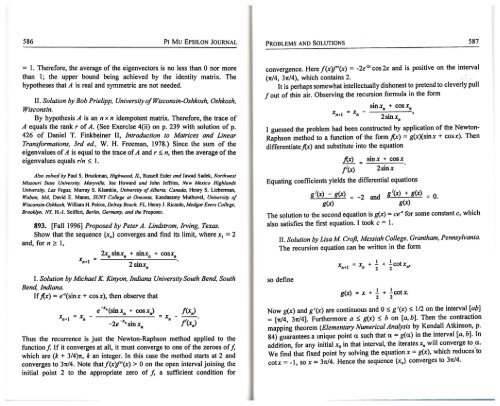Vol. 10 No 7 - Pi Mu Epsilon
Vol. 10 No 7 - Pi Mu Epsilon
Vol. 10 No 7 - Pi Mu Epsilon
Create successful ePaper yourself
Turn your PDF publications into a flip-book with our unique Google optimized e-Paper software.
586 PI MU EPSILON JOURNAL<br />
PROBLEMS AND SOLUTIONS 587<br />
= I. Therefore, the average of the eigenvectors is no less than 0 nor more<br />
than I; the upper bound being achieved by the identity matrix. The<br />
hypotheses that A is real and symmetric are not needed.<br />
II. Solution by Bob Prielipp, University of Wisconsin-Oshkosh, Oshkosh,<br />
Wisconsin.<br />
By hypothesis A is an n x n idempotent matrix. Therefore, the trace of<br />
A equals the rank r of A. (See Exercise 4(ii) on p. 239 with solution of p.<br />
426 of Daniel T. Finkbeiner II, Introduction to Matrices and Linear<br />
Transformations, 3rd ed., W. H. Freeman, I978.) Since the sum of the<br />
eigenvalues of A is equal to the trace of A and r ~ n, then the average of the<br />
eigenvalues equals rln ~ I.<br />
Also solved by Paul S. Bruckman, Highwood, IL, Russell Euler and Jawad Sadek, <strong>No</strong>rthwest<br />
Missouri State University, Maryville, Joe Howard and John Jeffries, New Mexico Highlands<br />
University, Las Vegas, <strong>Mu</strong>rray S. Klamkin, University of Alberta, Canada, Henry S. Lieberman,<br />
Waban, MA, David E. Manes, SUNY College at Oneonta, Kandasamy <strong>Mu</strong>thuvel, University of<br />
Wisconsin-Oshkosh, William H. Peirce, Delray Beach, FL, Henry J. Ricardo, Medgar Evers College,<br />
Brooklyn, NY, H.-J. Seiffert, Berlin, Germany, and the Proposer.<br />
893. [Fall I 996] Proposed by Peter A. Lindstrom, Irving, Texas.<br />
Show that the sequence {xn} converges and find its limit, where x 1 = 2<br />
and, for n ~ I,<br />
2x 11<br />
sinx + sinx + cosx X = II II<br />
11<br />
11+l<br />
2 smx .<br />
11<br />
I. Solution by Michael K Kinyon, Indiana University South Bend, South<br />
Bend, Indiana.<br />
Ifj{x) = e·.r(sinx + cosx), then observe that<br />
-x<br />
_ e "(sinx 11<br />
+ cosx 11<br />
) f(x 11<br />
)<br />
X 11<br />
+l - X 11<br />
- = X - --.<br />
-2e -x,. sinx<br />
11<br />
Thus the recurrence is just the Newton-Raphson method applied to the<br />
function f. If it converges at all, it must converge to one of the zeroes of J,<br />
which are (k + 3/4)1t, k an integer. In this case the method starts at 2 and<br />
converges to 37t/4. <strong>No</strong>te thatf(x)f''(x) > 0 on the open interval joining the<br />
initial point 2 to the appropriate zero of J, a sufficient condition for<br />
11<br />
/<br />
1<br />
(X11 )<br />
convergence. Here f(x)f''(x) = -2e-2.r cos 2x and is positive on the interval<br />
(7t/4, 37t/4), which contains 2. . . . ·-<br />
It is perhaps somewhat intellectually dishonest to pretend to cleverly pull<br />
f out of thin air. Observing the recursion formula in the form<br />
xll+l = x,. -<br />
sinx 11<br />
+ cosx 11<br />
2sinx 11<br />
I guessed the problem had been constructed by application of the Newton<br />
Raphson method to a function of the form j{x) = g(x)(sinx + cosx). Then<br />
differentiatej{x) and substitute into the equation<br />
j{x) = sinx + cosx<br />
f'(x) 2sinx<br />
Equating coefficients yields the differential equations<br />
g'(x) - g(x) = -2 and g'(x) + g(x) = 0.<br />
g(x)<br />
g(x)<br />
The solution to the second equation is g(x) = ce·.r for some constant c, which<br />
also satisfies the first equation. I took c = I.<br />
II. Solution by Lisa M Croft, Messiah College, Grantham, Pennsylvania.<br />
The recursion equation can be written in the form<br />
so define<br />
X X + .! + !cotx 11<br />
,<br />
n+l = 11<br />
2 2<br />
1 1<br />
g(x) = x + -<br />
2 2<br />
+ -cotx.<br />
<strong>No</strong>w g(x) and g'(x) are continuous and 0 ~ g'(x) ~ 1/2 on the interval [ap]<br />
= [7t/4, 37t/4]. Furthermore a ~ g(x) ~ b on [a, b]. Then the contraction<br />
mapping theorem (Elementary Numerical Analysis by Kendall Atkinson, p.<br />
84) guarantees a unique point a. such that a.= g(a.) in the interval [a, b]. In<br />
addition, for any initial x 0<br />
in that interval, the iterates xn will converge to _a..<br />
We find that fixed point by solving the equation x = g(x), which reduces .. to<br />
cotx = -I, so x = 37t/4. Hence the sequence {xn} converges to 37t/4.
















